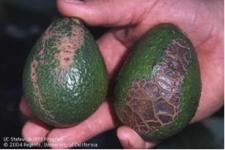Continual wind or infrequent wind storms can damage California avocado trees. Wind can have both chronic effects, where the trees are exposed to continual amounts of air movement, and acute effects where the tree are thrashed around by storm force winds.
The cultural management methods used to minimize the damaging effect of wind depends on whether the wind is reducing avocado yields and damaging fruit quality or if the grower needs to respond to a severe windstorm.
Chronic exposure to wind
- Avocado trees grown in windy parts of groves are usually stunted and have poor production compared to the more sheltered trees. Fruit on the wind-exposed trees is blemished by injuries from twigs and branches hitting the fruit at any time from when the fruit are "BB" sized through to harvest. The only way to reduce the stress on the tree is to provide a wind shelter that reduces the energy of the wind.
- Black marks caused by the wind can be mistaken for anthracnose post harvest rot. And russet scarring on avocados is easily confused with persea thrips damage. While the damage is clearly visible when the avocado is green, the damage is usually masked or hidden when the fruit ripen to a dark color.
- Superficial avocado skin damage is done solely to the top layer of the avocado skin. This damage does not extend for the full thickness of the skin and heals fairly quickly. The healed damage looks like small spots and takes on a black, sometimes shiny appearance. If the damage is done while the fruit are small the spotting will appear to spread as the fruit grows increasing the apparent amount of damage. This type of wind damage is easily hidden when the fruit ripen and is generally not serious with respect to quality.
- More serious, deeper damage to the avocado can result in a tear in the skin that heals by forming a scar or callus. Because the scar is rigid, it rips and heals repeatedly as the fruit grows, resulting in a bigger scar. The result is a "russet" type blemish on the skin that has angular "netting" and is sometimes referred to as alligator skin.
- When the fruit grow they don't expand evenly over the fruit and the scars fracture along lines of force. This is what causes the netting effect. If the skin is damaged when the fruit are very small the size of the russet area can cover a large percentage of the fruit by the time they are harvested. This type of damage is serious as too much russet blemish will downgrade the fruit.
- Chronic wind can also result in ragged leaves that tend to be smaller and result in compact and stunted trees. The chronic wind is probably causing additional water stress to the trees affecting the uptake of minerals. Roots are usually stressed as well by the rocking motion of the trees and the smaller canopy.
Avocado damage caused by severe wind events
- Severe winds can blow avocado trees over, break limbs or blow avocados off the trees. Damage depends on how strong the wind was, accompanying weather effects (such as rain), the amount of avocados on the trees and the structure of the avocado trees’ canopy of the trees affected.
- Damage to avocado trees is exacerbated by rain — making trees more vulnerable to being blown over. Large avocado trees with dense compact canopies are also vulnerable to tipping over and experiencing branch damage because the canopy acts like a large sail catching the wind.
- After a storm, windfall fruit must be disposed of properly. Growers should monitor fruit that remains on the tree, as well as branch and root health. Watch for signs of wilting that can indicate a broken branch or stressed roots.
Unless the trees are very young it is usually a bad idea to return fallen avocado trees to an upright position because this often causes damage to the remaining root system. Fallen trees or branches with wilted leaves are usually not going to recover and complete removal of these trees or branches is necessary.
